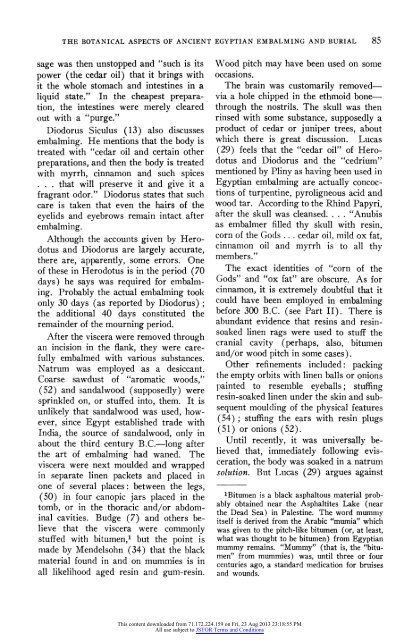The Botanical Aspects of Ancient Egyptian Embalming and Burial
The Botanical Aspects of Ancient Egyptian Embalming and Burial
The Botanical Aspects of Ancient Egyptian Embalming and Burial
Create successful ePaper yourself
Turn your PDF publications into a flip-book with our unique Google optimized e-Paper software.
THE BOTANICAL ASPECTS OF ANCIENT EGYPTIAN EMBALMING AND BURIAL 85<br />
sage was then unstopped <strong>and</strong> "such is its<br />
power (the cedar oil) that it brings with<br />
it the whole stomach <strong>and</strong> intestines in a<br />
liquid state." In the cheapest preparation,<br />
the intestines were merely cleared<br />
out with a "purge."<br />
Diodorus Siculus (13) also discusses<br />
embalming. He mentions that the body is<br />
treated with "cedar oil <strong>and</strong> certain other<br />
preparations, <strong>and</strong> then the body is treated<br />
with myrrh, cinnamon <strong>and</strong> such spices<br />
. . . that will preserve it <strong>and</strong> give it a<br />
fragrant odor." Diodorus states that such<br />
care is taken that even the hairs <strong>of</strong> the<br />
eyelids <strong>and</strong> eyebrows remain intact after<br />
embalming.<br />
Although the accounts given by Herodotus<br />
<strong>and</strong> Diodorus are largely accurate,<br />
there are, apparently, some errors. One<br />
<strong>of</strong> these in Herodotus is in the period (70<br />
days) he says was required for embalming.<br />
Probably the actual embalming took<br />
only 30 days (as reported by Diodorus);<br />
the additional 40 days constituted the<br />
remainder <strong>of</strong> the mourning period.<br />
After the viscera were removed through<br />
an incision in the flank, they were carefully<br />
embalmed with various substances.<br />
Natrum was employed as a desiccant.<br />
Coarse sawdust <strong>of</strong> "aromatic woods,"<br />
(52) <strong>and</strong> s<strong>and</strong>alwood (supposedly) were<br />
sprinkled on, or stuffed into, them. It is<br />
unlikely that s<strong>and</strong>alwood was used, however,<br />
since Egypt established trade with<br />
India, the source <strong>of</strong> s<strong>and</strong>alwood, only in<br />
about the third century B.C.-long after<br />
the art <strong>of</strong> embalming had waned. <strong>The</strong><br />
viscera were next moulded <strong>and</strong> wrapped<br />
in separate linen packets <strong>and</strong> placed in<br />
one <strong>of</strong> several places: between the legs,<br />
(50) in four canopic jars placed in the<br />
tomb, or in the thoracic <strong>and</strong>/or abdominal<br />
cavities. Budge (7) <strong>and</strong> others believe<br />
that the viscera were commonly<br />
stuffed with bitumen,1 but the point is<br />
made by Mendelsohn (34) that the black<br />
material found in <strong>and</strong> on mummies is in<br />
all likelihood aged resin <strong>and</strong> gum-resin.<br />
Wood pitch may have been used on some<br />
occasions.<br />
<strong>The</strong> brain was customarily removedvia<br />
a hole chipped in the ethmoid bonethrough<br />
the nostrils. <strong>The</strong> skull was then<br />
rinsed with some substance, supposedly a<br />
product <strong>of</strong> cedar or juniper trees, about<br />
which there is great discussion. Lucas<br />
(29) feels that the "cedar oil" <strong>of</strong> Herodotus<br />
<strong>and</strong> Diodorus <strong>and</strong> the "cedrium"<br />
mentioned by Pliny as having, been used in<br />
<strong>Egyptian</strong> embalming are actually concoctions<br />
<strong>of</strong> turpentine, pyroligneous acid <strong>and</strong><br />
wood tar. According to the Rhind Papyri,<br />
after the skull was cleansed...... "Anubis<br />
as embalmer filled thy skull with resin,<br />
corn <strong>of</strong> the Gods . . . cedar oil, mild ox fat,<br />
cinnamon oil <strong>and</strong> myrrh is to all thy<br />
members."<br />
<strong>The</strong> exact identities <strong>of</strong> "corn <strong>of</strong> the<br />
Gods" <strong>and</strong> "ox fat" are obscure. As for<br />
cinnamon, it is extremely doubtful that it<br />
could have been employed in embalming<br />
before 300 B.C. (see Part II). <strong>The</strong>re is<br />
abundant evidence that resins <strong>and</strong> resinsoaked<br />
linen rags were used to stuff the<br />
cranial cavity (perhaps, also, bitumen<br />
<strong>and</strong>/or wood pitch in some cases).<br />
Other refinements included: packing<br />
the empty orbits with linen balls or onions<br />
painted to resemble eyeballs; stuffing<br />
resin-soaked linen under the skin <strong>and</strong> subsequent<br />
moulding <strong>of</strong> the physical features<br />
(54); stuffing the ears with resin plugs<br />
(51) or onions (52).<br />
Until recently, it was universally believed<br />
that, immediately following evisceration,<br />
the body was soaked in a natrum<br />
solution. But Lucas (29) argues against<br />
lBitumen is a black asphaltous material probably<br />
obtained near the Asphaltites Lake (near<br />
the Dead Sea) in Palestine. <strong>The</strong> word mummy<br />
itself is derived from the Arabic "mumia" which<br />
was given to the pitch-like bitumen (or, at least,<br />
what was thought to be bitumen) from <strong>Egyptian</strong><br />
mummy remains. "Mummy" (that is, the "bitumen"<br />
from mummies) was, until three or four<br />
centuries ago, a st<strong>and</strong>ard medication for bruises<br />
<strong>and</strong> wounds.<br />
This content downloaded from 71.172.224.159 on Fri, 23 Aug 2013 23:18:55 PM<br />
All use subject to JSTOR Terms <strong>and</strong> Conditions
















